Currently, one of the main tasks of the
museum activities to find new ways to interact with the audience, taking into
account modern technological trends, in particular virtual and augmented
reality technologies [1-3]. Virtual Reality (VR) is a hardware and software
technical system that provides the effect of a three-dimensional interactive
environment in which the user experiences a sense of presence (immersion)
[4-7].
Augmented Reality (AR) is a technology that
integrates virtual objects into the real physical world. Special augmented
reality glasses, such as Magic Leap [8] or Microsoft HoloLens [9], can be used
to implement this technology. There is a method of demonstrating augmented
reality on large screens, for example in shopping malls or at public transport
stops.
Currently, smartphones and tablets are used
as devices for demonstrating augmented reality objects. Modern mobile devices
are equipped with a GPS/GLONASS receiver, compass, accelerometer and gyroscope,
which allows for tracking the movement and position of the device in space.
Using the built-in camera, they receive a video stream of the real surrounding
space. Then, with the help of special software, virtual content is superimposed
on the video stream received from the camera (in particular, three-dimensional
models, animated scenes, videos, photographic images, etc.), taking into
account the change in the position and orientation of the device in space. The
final combined video stream is displayed on the screen of the mobile device.
In the presented work, the authors consider
the issues of using augmented reality technology for former images of destroyed
Orthodox churches against the background of the 21st century reality. The use
of modern information technologies allows people who live today to see what
people who lived 120-140 years ago saw back then [10].
Currently, the most common way is to use
web-based applications (Web Based App), which allow demonstrating augmented
reality directly in the browser of a phone or a tablet. To do this, users do
not need to install any additional applications, but just click on the link.
One of the tools for creating AR applications for the web is AR.js [11]. This
freely distributed software, developed in the JavaScript programming language,
uses three principles of building augmented reality based on: Marker Tracking;
Location Based tracking; Image Tracking.
Specially prepared images serve as a marker
(label) when using the "marker tracking" principle. The labels should
be high-contrast (usually black and white), and the images on them should not
have central symmetry. For example, a single image of a symbol, letter or
number, simple geometric shapes such as a square or triangle, as well as a bar
code can serve as a marker. Such markers can be printed, for example, on a book
page or in an advertising booklet. When pointing the camera at the marker, the
user sees virtual AR content projected onto it. The disadvantage of this method
is that it is necessary to place pre-printed markers in the required places of
the real physical world in advance. However, the recognition quality of such
special tags is very high and, importantly for mobile devices, does not require
large computational costs.
When using the "coordinate
tracking" principle, the user sees virtual AR content in specified
locations based on data received from GPS/GLONASS receivers built into the
phone or tablet. Virtual AR content is linked to a key point with previously known
geographical coordinates (latitude and longitude). It should be remembered that
the maximum accuracy of GPS/GLONASS positioning does not exceed 3-5 meters. In
practice, the positioning accuracy is influenced by a lot of factors (density
and type of urban development, weather conditions, the presence of radio
interference, etc.) and it can decrease to several dozens of meters. Therefore,
we are not talking about any precise positioning of objects. The maximum that
can be obtained in this mode is to provide access to certain AR content when
the user is in some area of a given radius around the key point.
When using the "image
recognition" principle, real objects are recognized, the images of which
were captured by the camera. Compared with the recognition of special markers,
this task is much more demanding on the computing resources of a smartphone or
tablet, while the reliability of recognition is lower.
The problem of using augmented reality to
preservation and reconstruction of cultural heritage is widely discussed in the
literature. In the study [12], the authors developed a geolocation-based AR
application to demonstrate the Roman Baths of Ankara, Turkey. The data source
for building the model of the baths were photographs and geographical coordinates
obtained from a drone.
The city of Bandung in Indonesia has a
large number of historical buildings. The authors have developed an AR
application based on coordinate tracking, which helps to study the history of
this city more deeply [13].
In [14], the authors conducted a study of
the effectiveness of using augmented reality in the study of history. In the
course of the research, a mobile application developed by the McCord Museum was
used, which allows finding historical sights of Montreal based on tracking
geographical coordinates.
Currently, significantly detailed virtual
models of cultural heritage sites, which naturally include many complex
elements in terms of their visualization, have a volume of more than 10 MB. At
the same time, recommendations for downloading 3D models in augmented reality
mode to ensure the best user experience are as follows: the recommended total
size of 3D files uploaded to the platform should be less than 10 MB (10 MB
=> 10 seconds of downloading from 4G /5G /Wifi). It is important to minimize
the size of the 3D file before uploading it [15]. This limitation is related to
the technical capabilities of modern computing technology, in particular cell
phones and tablets, as the results of the authors' work are aimed for users of
these devices.
In this regard,
during this study, the authors simplified the three-dimensional models
described in the work so that they could be quickly downloaded via a mobile
network and displayed with acceptable quality on the screens of cell phones and
tablets in augmented reality mode against the background of a real area. GLB
(GL Transmission Format Binary file) files were used to store 3D models. The
GLB format is a binary version of the GLTF format, which, in turn, is based on
JSON (JavaScript Object Notation). A single standalone binary GLB file contains
all information about 3D model geometry, scenes, lighting, materials, node
hierarchy, and animations. To reduce the size of the GLB file, the following
approaches were used: reducing the number of polygons of the model; smoothing
(reducing the number of nodes) of the grid; removing invisible parts of the
model; minimizing the number of materials to reduce the number of textures
used; if possible, replacing the textures of materials with a simple fill with
a monochrome color; if filling with color is undesirable due to a decrease in
the quality of visualization, then reducing the resolution of the textures was used;
compressing textures into jpeg format; if possible, deleting all animations; if
it is undesirable to completely remove the animation, then reducing the number
of keyframes. In the process of optimizing GLB files, it is necessary to
monitor intermediate results using a viewing program in order to assess changes
in the quality of visualization.
Let's consider the application of the
technology described above for visualization of former images of destroyed churches
against the background of the XXI century reality on the example of three of
the seventeen temples of Tambov that existed at the beginning of the XX
century: the Church in honor of the Intercession of the Blessed Virgin Mary,
the church in the name of the First Martyr Archdeacon Stephen (Utkin Church)
and the church in the name of the Great Martyr Barbara (Varvarinskaya Church).
The scientific research conducted by the
staff of Tambov State Technical University within the framework of the RNF
grant (project No. 19-14-00044) touches on certain points in the biographies of
famous people whose destinies were once connected with the city of Tambov.
Among them: a scientist of world importance, the founder of the doctrine of the
noosphere V.I. Vernadsky, a public figure, lawyer, historian Chicherin B.N., a
political and statesman, diplomat Chicherin G.V. [16], composer, pianist,
conductor Rachmaninov S.V. [17], entrepreneur, public figure Aseev M. V. [18],
winner of the Stalin Prize, Doctor of Medicine, professor, famous
archbishop-surgeon St. Luke (Voino-Yasenetsky) [19].
The fate and work of each of them was
somehow connected with the city of Tambov, which during their lifetime was the
administrative center of one of the largest provinces in terms of area and
population in the European part of the Russian Empire. nobles Chicherins lived
in their city estates, going to their ancestral estate, the village of Karaul,
for the summer. The famous manufacturer M.V. Aseev lived there almost
constantly with his family. The great scientist V.I. Vernadsky, who is known
far beyond the borders of Russia, visited Tambov because of the fulfillment of
his public duties related to the activities of the Provincial Zemstvo Assembly.
The famous Russian composer S.V. Rachmaninov also visited Tambov, although his
visits to the provincial center cannot be called rare. During the Great
Patriotic War, the renowned archbishop-surgeon St. Luke (Voino-Yasenetsky)
served and revived the Tambov diocese, and tried to restore the temples of the
city of Tambov.
In the course of scientific research, the
authors collected the necessary information on those places in the Tambov
region that were touched upon in the biographies of the above-mentioned famous
people of Russia [20-23]. Later, on the basis of the collected information, the
authors developed virtual museums using modern computer technology tools, in
particular the Twinmotion software environment [24], including the museums at
the place of residence of the Chicherins and Aseevs in the city of Tambov [25].
However, it can be argued that all of the noted famous compatriots have been in
the immediate vicinity many times or were in certain places of urban
facilities, which it was simply impossible to avoid. First of all, these include
the Orthodox churches of the city of Tambov. There were 17 of them in the
patriarchal, provincial city of Tambov at the beginning of the XX century. The
photo of the end of the XIX century shows a significant part of them (see Fig.
1) [26].
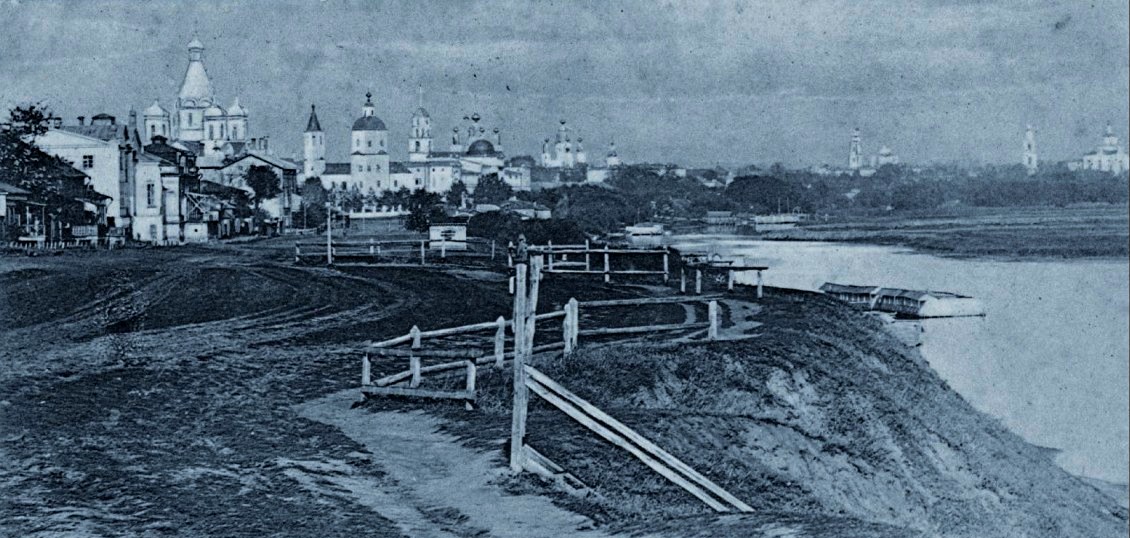
Fig.
1. View of the Orthodox churches of Tambov from the side of the Tsna River
(photo of the end of the XIX century)
It was these urban sites that were more or
less well known to famous people, which were mentioned above. Each of them knew
well such Tambov temples as the Transfiguration Cathedral - the oldest church
in the city of Tambov, the Intercession Churches on the banks of the Tsna
River, the Utkin Church of the First Martyr Archdeacon Stephen, located in the
very center of the city at the intersection of Dvoryanskaya and Dolgaya
Streets, the Cathedral of the Nativity, located on the Bazarnaya Square, and
the Varvarinskaya Church in the southern part of the city.
A number of temples have survived to the
present day, but most of them were demolished during the years of so called
"militant atheism". But at the time when the Chicherins and Aseevs
lived in Tambov, when Rachmaninov and Vernadsky often visited him, these
temples were the decoration of the city. These temples have always served the
cause of faith - the glorification of God and testified to the beauty of God's
world, they embodied the culture of the Russian people, their understanding of
beauty. Of course, these creations could not leave famous people indifferent,
to whom this scientific work is devoted. At its conclusion, a number of virtual
developments were carried out, which allow us, living in the XXI century, to
imagine what people could see with their own eyes 120-140 years ago, whom
descendants remember with due respect and love in our time.
The church in honor of the Intercession
of the Most Holy Theotokos.
Let's start with the
church, which since the XVII century was called the Temple in honor of the
Intercession of the Blessed Virgin Mary. It has always been called simpler by
the people – Pokrovskaya. The importance of this temple was great for the
townspeople, as it was a kind of symbol of the protection of the city, which,
as a fortress city, was consecrated on the day of the feast of the Intercession
of the Blessed Virgin Mary. The first written information about it was
discovered in the middle of the XIX century in the description left by voivode
Polevoy in 1659. It was noted there that the wooden church was located in
Pokrovskaya Sloboda on the riverbank south of the fortifications of the Tonbov
fortress [27]. After a fire in 1763, the Intercession Church was rebuilt in
stone. The largest information material about this church was published in 2001
in the monograph of the clergyman V.F. Lisyunin "The History of the
Intercession Cathedral of Tambov" [28].
From this work, readers can learn that the building
of this church, with some internal alterations made in different years, has
survived to the present day. The latter was very important for us, because it
left no doubt that the appearance of the temple had not changed over the past
150 years. By the 40s of the XIX century, the number of Orthodox believers in
Tambov had become so large that it could not match the total volume of prayer
rooms of all Tambov churches operating at that time. Only the construction of a
new church could change this situation. The Holy Synod gave permission for its
construction in 1843 [28]. The construction process itself was associated with
a number of engineering problems that led to its shutdown and resumption after
significant changes in the design documentation. The construction was carried
out with funds left by the Tambov merchant I.M. Baykov. The new Intercession
Church was located just a few meters from the old church behind the bell tower
to the west of it. The question remains unclear as to why the new church was
built near the old one. It was much larger in volume and dominated the
background of the old church. The latter is well confirmed by photographs of
the architectural ensemble of the Intercession Churches, which were taken at
the turn of the XIX and XX centuries. The new Intercession Church existed from
1869 to the end of the 30s of the last century. Figure 2 shows a view of the
Church in honor of the Intercession of the Blessed Virgin Mary (photo by P.S.
Moskalev printing house).
At that time, there was an acute shortage
of bricks in Tambov for the construction of industrial and military facilities
that were being carried out on the outskirts of the city. This was the reason
that the New Intercession Church was closed and dismantled, sending the brick
for other needs. Thus, nowadays, only the Old Intercession Church of the
considered ensemble of the Intercession Churches has been preserved and it is
still in operation today. It was in this church where St. Luke
(Voino-Yasenetsky) served. In 1944-1946, as Archbishop of Tambov and
Michurinsk, he began the revival of the Tambov diocese.
Ten years ago, by decision of the
leadership of the Tambov diocese, excavations were carried out at the proposed
site of the dismantled New Intercession Church. As a result, the foundation of
the church was completely cleared, which made it possible to accurately
determine the location of the temple.
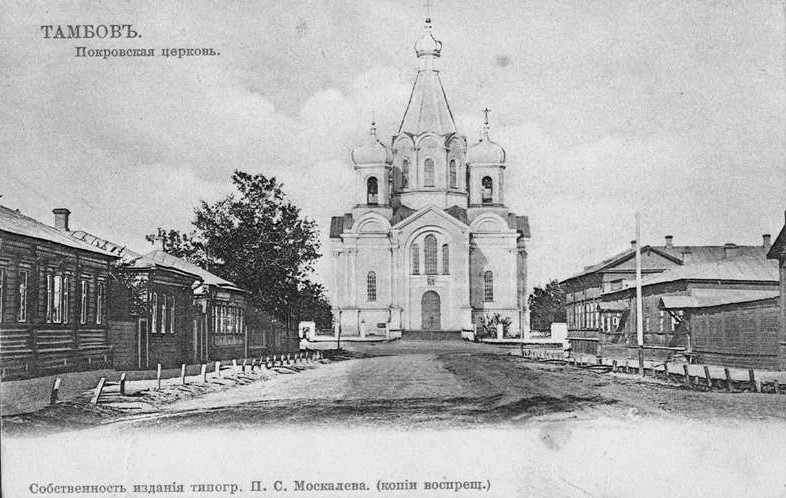
Fig.
2. View of the Church in honor of the Intercession of the Most Holy Theotokos
(photo by P.S. Moskalev printing house)
The Old and New Intercession Churches,
located on the Naberezhnaya street of the city of Tambov, were closest to the
city estate of the Chicherin nobles [26]. It was located on the corner of
Bolshaya Astrakhanskaya and Pokrovskaya streets in the 55th city block (nowadays
Sovetskaya and Kronshtadtskaya streets). At the turn of the XIX and XX
centuries, B.N. Chicherin often visited here and remained a religious man all
his life. The family members of the Chicherin nobles were parishioners of the
Intercession Church, the building of which was no more than 70 meters from
their city estate. In Fig. 3 shows the visualization of the image of the
destroyed Temple in honor of the Intercession of the Blessed Virgin Mary
against the background of the XXI century scenery created using augmented
reality technology.
The Church in the name of the First
Martyr Archdeacon Stephen (Utkinskaya Bogoroditskaya Church).
The second religious object, which at that time was known to all
guests and residents of Tambov, was the church in the name of the First Martyr
Archdeacon Stephen. The townspeople called it Utkinskaya by the name of I.F.
Utkin, a Tambov merchant who was the first to finance the construction of this
church. It was votive and was built according to a vow in gratitude for getting
rid of the cholera epidemic that swept the Tambov Region in 1771. The first
version of the church remained unknown to us. No drawings or pictures have been
preserved. In the 30s of the XIX century, the reconstruction of the Utkin
Church began. The second variant in appearance embodied several architectural
trends in the cult buildings of the middle of the last century. As a result,
the exterior of the rebuilt church in 1857 combined elements of ancient Russian
architecture, Byzantine architecture and Russian Baroque. At that time it was
the largest church in Tambov. It was built according to a cruciform plan. Its
geometric structure consisted of simple geometric shapes – a cube that
incorporated a prayer room and an altar, a horizontal prism that served as a
frame structure for the refectory. The latter connected the main prayer room
with the narthex, above which there was a three-tiered bell tower. Already in
the second half of the XIX century, the most of the Utkin Church was thoroughly
decorated with complex architectural elements that brought extraordinary
beauty. These include four-column porticos on three sides of the main cube.
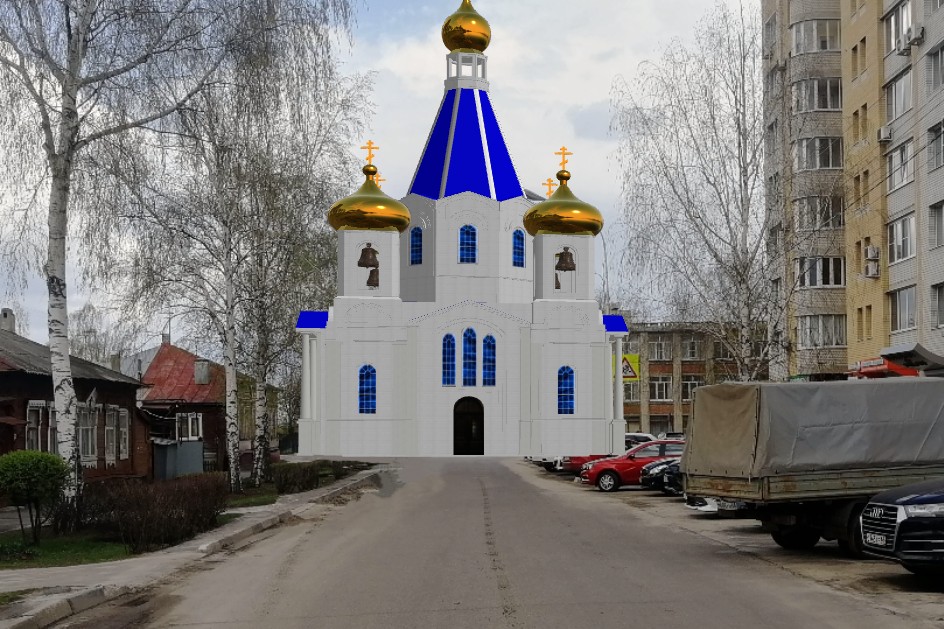
Fig.
3. Visualization of the image of the destroyed Temple in honor of the Intercession
of the Blessed Virgin Mary against the XXI century background using augmented
reality technology
Porticos with double columns decorated the
central drum, towering over the main building, and above its corner points
there were 4 domes similar to the central one, crowned with Orthodox crosses.
The rich decor throughout the main building made the temple the most beautiful
of all the religious buildings of the city of Tambov [29]. In 1873, a chapel
was built in the southeastern corner of the church fence, in which a copy of
the icon of the Tambov Mother of God was kept, therefore the temple was also
called Bogoroditsky. It was considered miraculous. In June 1918, a Socialist
Revolutionary uprising took place in Tambov, during the suppression of which the
bell tower of this church was used for military purposes for the first time in
the history of the Tambov Region. At that time, it had a tremendous negative
impact on many residents of the city, leaving an indelible impression in their
minds. In 1931, by the decision of the city executive committee, this church
was closed. One of the reasons for this was the location of the temple, which
blocked the roadway of Mezhdunarodnaya Street at its intersection with K. Marx
Street (formerly Dvoryanskaya and Dolgaya).
To date, 9 photographs of the Utkin Church
in Tambov have been preserved. All of them were made in the last years of the
XIX – in the first years of the XX centuries. The church is depicted on them
from all 4 sides, however, it was not possible to take pictures from the south
and from the north perpendicular to the walls of the temple - the buildings
along Dolgaya Street prevented it. For this reason, the pictures were taken
from the side of the Tsna hotel – from the southeast, and from the side of the building
of the Noble Provincial Assembly (now the regional drama theater) - from the
northeast. These pictures, taken from side angles, clearly reflect the eastern
(altar) wall of the temple and partially the southern and northern walls.
However, the most important for determining the exact location of the former
church are the photographs taken from the western side – from the station along
Dvoryanskaya Street (nowadays Internatsionalnaya). Figure 4 shows a view of the
Utkinskaya Bogoroditskaya Church of the early 20th century.
A thorough analysis of old photographs, as
well as a copy of the Tambov city plan, made in 1914, made it possible to
determine with high probability the location of the former most beautiful
Orthodox church in Tambov. This city plan was the first to mark the locations
of the main stone buildings in the central city blocks. The plan shows that the
western wall of the Utkin Church was in line with the western wall, the
above-mentioned second house on the north side of the street, and on the
opposite side on the same line was the western end wall of the building that
has survived to the present day.
Visualization of the image of the destroyed
Utkin Bogoroditskaya Church against the background of the XXI century scenery using
augmented reality technology is shown in Fig. 5.
The Church in the name of the Great
Martyr Barbara (Varvarinskaya Church).
The third
Orthodox church in Tambov, which we paid attention to in our scientific
research in order to introduce it into the register of virtual museums of the
city of Tambov, was the church built in the name of the Great Martyr Varvara
(Varvarinskaya).
The first mention of it is found in the
documents of 1806 [30]. The church was located on the southern outskirts of the
city and was a center of the new development that appeared around it. By the
end of the 19th century, the dilapidated building required major repairs, which
could not be carried out due to the lack of necessary funds.
The required funds were provided in 1909 by
the Tambov manufacturer M.V. Aseev, who had been elected by the parishioners
the year before as the head of the church community. Together with another
Tambov philanthropist L.V. Vysheslavtsev, all expenses in the amount of 32
thousand rubles were paid. By that time, it was the largest monetary investment
for church needs in the city of Tambov.
Some drawings for major repairs on the
Varvarinskaya Church executed by the city architect I.F. Fedorovsky have been
preserved [31, 32], from which it became known that the total length of the
church building was 23 fathoms, and the height was 15 fathoms. During the
renovation, the church was surrounded by a fence made of metal sections. The
view of the Varvarinsky Church is shown in Fig. 6.
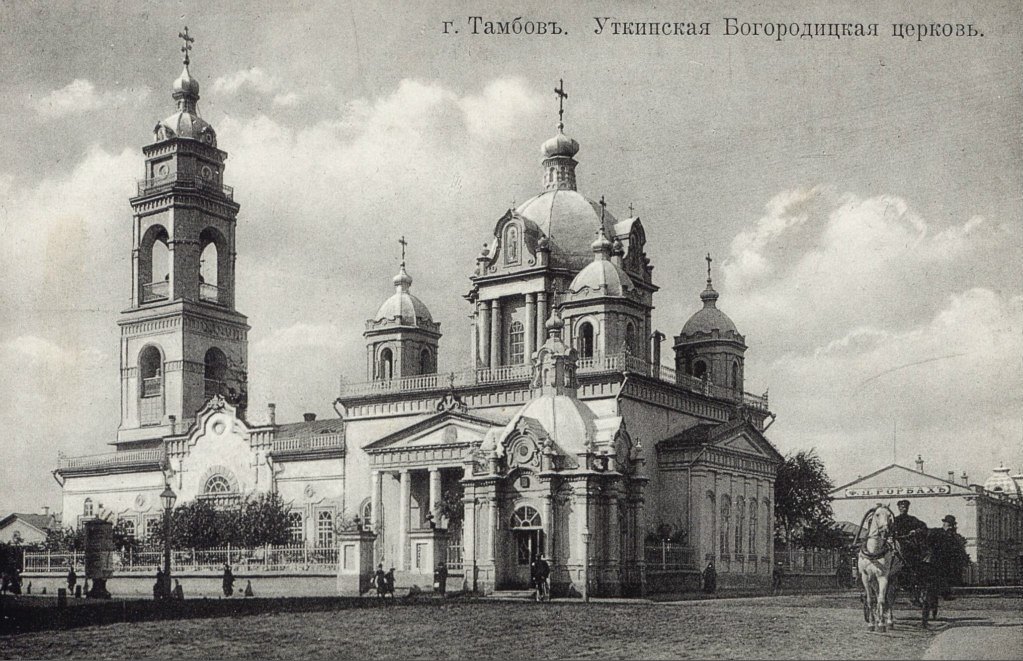
Fig.
4. View of the Utkinskaya Bogoroditskaya Church
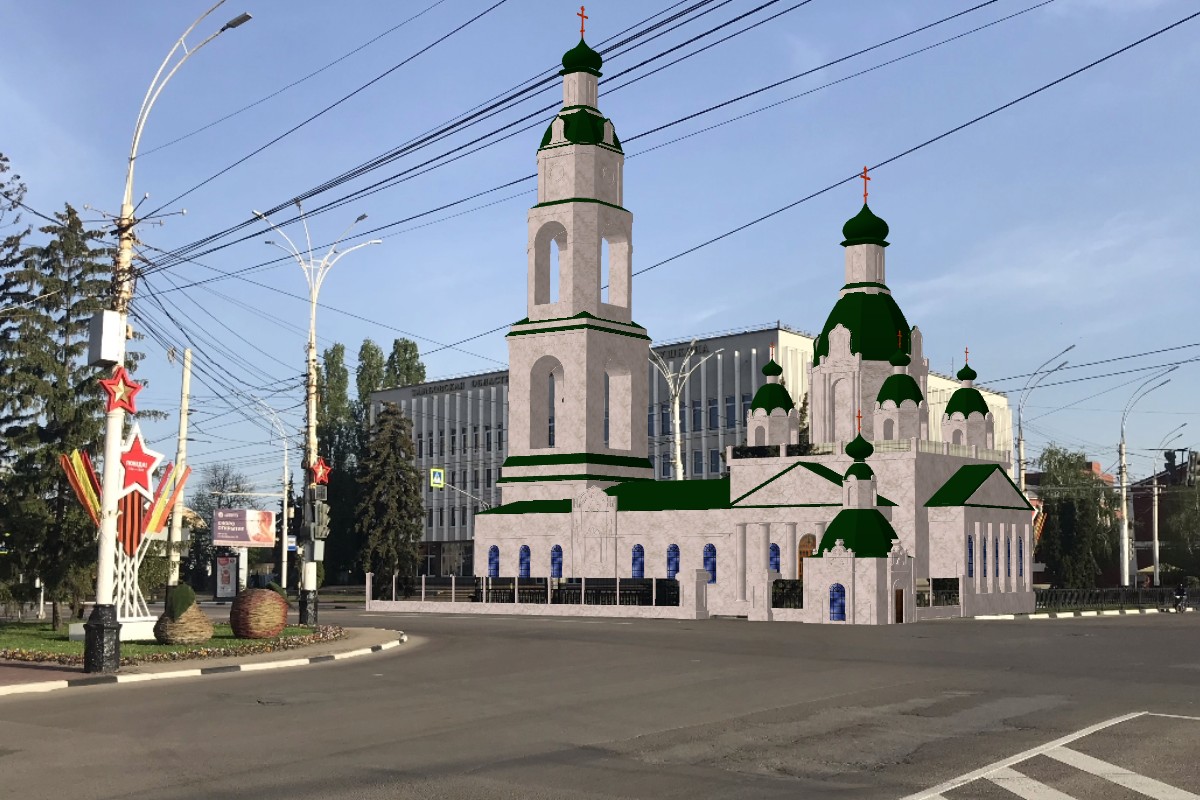
Fig.
5. Visualization of the image of the destroyed Utkin Bogoroditskaya Church
against the XXI century background using augmented reality technology
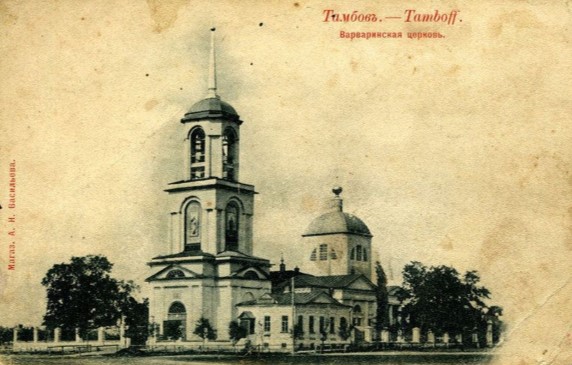
Fig.
6. View of the Varvarinsky Church
In 1929, a long process began to involve
the city's public in the issue of closing this church [32]. It was positively
resolved and in 1935 the Varvarinsky Church was dismantled.
We found only 4 pictures of the Varvarinsky
Church. Three of them were made from the north side, and the fourth one shows
the church from the northwest side. The location of the church was known from
schematic images on old maps of the city of Tambov. It is difficult to
determine this from the photographs, since none of them have specific images of
any buildings located near the Varvarinsky Church. It is known for sure that
the church stood in the southern part of Varvarinskaya Square, which was
crossed by a dirt road that served as the beginning of the Astrakhanskaya road.
Later, the road was moved to bypass the church, placing it on the southern side
of the latter. Presumably, the church stood perpendicular to the axis of the
square and was divided into two approximately equal parts by it.
Visualization of the image of the destroyed
Barbarian Church against the background of the XXI century scenery using
augmented reality technology is shown in Fig. 7.
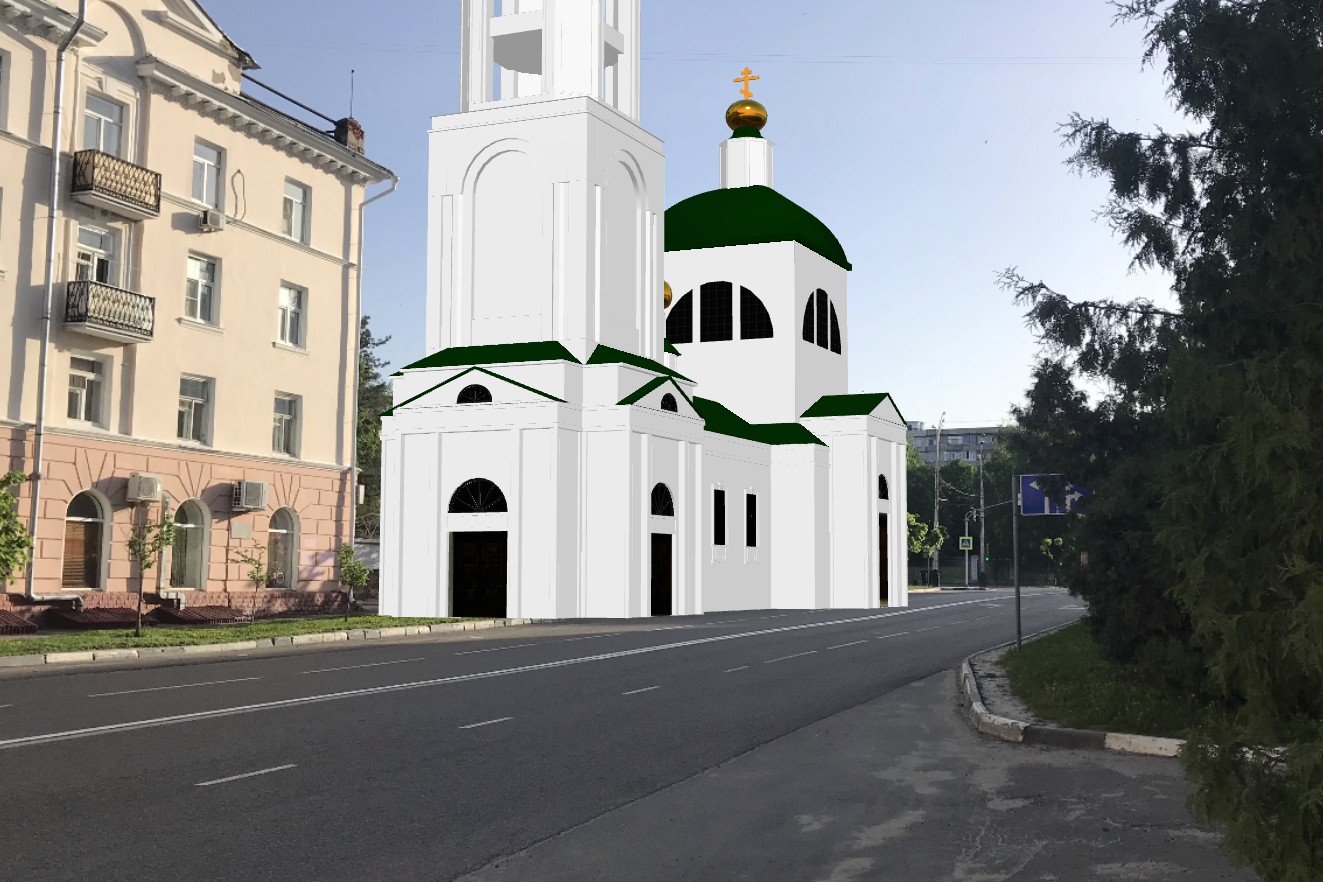
Fig.
7. Visualization of the image of the destroyed Barbarian Church against the XXI
century background using augmented reality technology
As a result of the conducted research, it
was found that of the 17 Orthodox churches in Tambov, a significant part was
destroyed during the years of so called "militant atheism." These
temples were the decoration of the city and have always served not only
religious purposes, but also embodied the culture of the Russian people, their
understanding of beauty. Of course, these creations could not leave indifferent
the famous people of Russia who lived and worked in the Tambov region in the
late XIX – early XX century.
The authors of this work have presented what
people who lived 120-140 years ago could see with their own eyes to their
descendants living in the XXI century, who remember their ancestors with due
respect and love.
As an illustration of augmented reality
technology, readers of the magazine are invited to restore the image of one
destroyed Orthodox church in Tambov, the Church in honor of the Intercession of
the Blessed Virgin Mary, on the plane of the page of this article. To do this,
use your smartphone to scan the QR code in Figure 8, then go to the page of the
specified site using Chrome or Safari browsers, allow access to the phone's
video camera and point the camera at the marker. An image of the temple will
appear on the phone screen.
|

|

|
|
a)
|
b)
|
Figure 8. QR code (a) and marker (b) to restore the
image of the Church in honor of the Intercession of the Blessed Virgin Mary
using augmented reality technology
1.
Robles-Ortega M. D., Feito F. R., Jiménez
J. J. and Segura R. J. (2012) “Web technologies applied to virtual heritage: An
example of an Iberian Art Museum”.
J. Cult. Herit
. 2012. no. 13(3) pp.
326–331 doi: 10.1016/j.culher.2011.10.001
2.
Guidi G., Russo M., Angheleddu D. (2014) “3D
survey and virtual reconstruction of archeological sites”
Digit. Appl.
Archaeol. Cult. Herit
. 2014. vol. 1. no. 2. pp. 55–69.
3.
Nisiotis L., Alboul L., Beer M.
(2019) “Virtual Museums as a New Type of Cyber-Physical-Social System”.
Augmented
Reality, Virtual Reality, and Computer Graphics. AVR 2019
. Lecture Notes in
Computer Science, 2019. vol. 11614, pp. 256–263.
4.
Kersten T., Tschirschwitz F., Deggim S.,
Lindstaedt M. (2018) “Virtual Reality for Cultural Heritage Monuments – from 3D
Data Recording to Immersive Visualisation”.
Euro-Mediterranean Conference
.
2018. pp. 74–83. doi: 10.1007/978-3-030-01765-1_9.
5.
Nemtinov V.A., Borisenko A.B., Nemtinova Yu.V.,
Gorelov A.A., Tryufilkin S.V. Implementation of technology for creating virtual
spatialtemporal models of urban development history // Scientific Visualization
2018. ¹ 3, P. 99–107. doi: 10.26583/sv.10.3.07.
6.
Gorelov I., Nemtinov V., Nemtinova Yu. (2019)
“Development of an information model of a virtual space of a historically
significant territory”
Journal of Physics: Conference Series
. 2019.
vol. 1278. pp. 012007. doi:10.1088/1742-6596/1278/1/012007
7.
Martinez1 K. P., Untalan1 M. Z. G., Burgos1 D.
F. M., Ramos1 R. V., Germentil1 M. J. Q. (2019) “Creation of a Virtual Reality
Environment of a University Museum Using 3D Photogrammetric Models”.
Int.
Arch. Photogramm. Remote Sens. Spat. Inf. Sci
. 2019. vol. 42. no.2.
pp. 841–847. doi:10.5194/ISPRS-ARCHIVES-XLII-2-W13-841-2019
8.
Magic Leap. Augmented reality platform for
Enterprise. Magic Leap (2023) [Electronic resource]. URL:
https://www.magicleap.com/en-us.
9.
Microsoft. Microsoft HoloLens. Mixed Reality
Technology (2023) [Electronic resource]. URL: https://www.microsoft.com/en-us/hololens.
10.
Nemtinov V.A., Gorelov A.A., Borisenko A.B.,
Nemtinova Yu.V., Morozov V.V. (2021) “Information analysis of memorable places
associated with the stay and activities of the scientist, plant biologist I.V.
Michurin in Michurinsk”.
Voprosy Istorii
. 2021. no. 8(2), pp. 163—171.
Doi: 10.31166/VoprosyIstorii202108Statyi43 (in Russian).
11.
AR.js org. AR.js - Augmented Reality on the Web
[Electronic resource]. URL:
https://ar-js-org.github.io/AR.js/.
12.
Unal M., Bostanci E., Sertalp E., Guzel M.,
Kanwal N. (2018) “Geo-location Based Augmented Reality Application For Cultural
Heritage Using Drones”.
2nd International Symposium on Multidisciplinary
Studies and Innovative Technologies (ISMSIT): IEEE
, 2018. pp. 1–4.
doi:10.1109/ISMSIT.2018.8567073
13.
Renaldy R., Zakiah A. (2020) “Development Mobile
Application of Bandung Tempo Doeloe based on Augmented Reality Using GPS
Tracking Method”.
Int. J. Inf. Eng. Electron. Bus.
2020. vol. 12. no.
2. pp. 9–14.
14.
Harley J. M., Lajoie S. P., Tressel T, Jarrell
A. (2020) “Fostering positive emotions and history knowledge with
location-based augmented reality and tour-guide prompts”.
Learning and
Instruction
. 2020. vol. 70. 101163. Doi:10.1016/j.learninstruc.2018.09.001
15.
Uploading 3D models to AR Code, what is the file
size and format? [Electronic resource]. URL: https://ar-code.com/ru/blog/%D0%B7%D0%B0%D0%B3%D1%80%D1%83%D0%B7%D0%BA%D0%B0-3d-%D0%BC%D0%BE%D0%B4%D0%B5%D0%BB%D0%B5%D0%B9-%D0%B2-ar-code-%D0%BA%D0%B0%D0%BA%D0%BE%D0%B9-%D1%80%D0%B0%D0%B7%D0%BC%D0%B5%D1%80-%D0%B8-%D1%84%D0%BE%D1%80%D0%BC%D0%B0%D1%82-%D1%84%D0%B0%D0%B9%D0%BB%D0%B0
16.
Thomas L.Ya. (2010) “The Life of G.V.
Chicherin". Moscow: Sobranie, 2010. 280 p (in Russian).AR.js org. AR.js -
Augmented Reality on the Web (2022) [Electronic resource]. URL:
https://ar-js-org.github.io/AR.js/.
17.
Tambov Encyclopedia (2004) / edited by L.G.
Protasov. Tambov: Yulis, 2004. 708 p. (in Russian)
18.
Tambov pilgrim. A guide to the holy places of the Tambov Metropolis
(2014).
Tambov: Yulis, 2014. 248 p (in Russian).
19.
Lisyunin, V.F., priest.(2012) “Tambov Golgotha
of St. Luke : (according to eyewitnesses) Tambov” : monograph / priest Viktor
Lisyunin. – Tambov : Publishing House of TSU named after G.R.Derzhavin, 2012. –
540 p. (in Russian).
20.
Lisyunin, V.F., priest. (2013) “The Intercession
Cathedral of Tambov and Orthodox traditions”: a monograph / Priest Viktor
Lisyunin. – Tambov : Publishing house of the TROO "Business
Science–Society", 2013. – 432 p. (in Russian).
21.
Lisyunin, V.F., Archpriest. (2021) “The revival
of the Tambov Diocese during the ministry of St. Luke (Voino-Yasenetsky) on the
material of state, departmental and private archives)” : monograph / Archpriest
Viktor Lisyunin. – Tambov : Publishing House "Derzhavinsky", 2021.
676 p. (in Russian).
22.
Lisyunin, V.F., Archpriest. (2022) “Towards
grace. Pilgrimage to the city of Tambov” : monograph / Archpriest Viktor
Lisyunin. – Tambov : Publishing House "Derzhavinsky", 2022. – 256 p.
(in Russian).
23.
Viazinkin A.Y., Dvuhzhilova I.V.,
Gorelov A.A. (2020) “Formation of a “Memorial Place”: Commemorative
Materials and Virtual Reconstruction (On the Example of the Memorial Place
“Ivanovka”)”.
Proceedings of the First International Volga Region Conference
on Economics, Humanities and Sports
(FICEHS 2019).
Paris: Atlantis
Press, 2020. pp. 570–573. doi:10.2991/aebmr.k.200114.132
24.
Twinmotion. Real-time immersive 3D architectural
visualization. (2023) [Electronic resource]. URL: https://www.unrealengine.com/en-US/twinmotion.
25.
Nemtinov V.A., Gorelov A.A., Nemtinova Yu.V.,
Borisenko A.B. (2020) “Virtual immersion in the temporary periods of stay in
the Tambov Region of representatives of the Chicherin family – famous figures
of the Russian diplomatic service”
Bylye Gody
, 2020. 58, No. 4. pp.
2305-2314. doi: 10.13187/bg.2020.4.2305 (in Russian).
26.
Lisyunin V.F. (2023) “The history of the
Intercession Cathedral of the city of Tambov". [Electronic resource]. URL:
http://pokrov-tmb.prihod.ru/istoriya-pokrovskogo-sobora-goroda-tambova/ (in
Russian).
27.
Kuchenkova V.A. (1993) “Tambov Orthodox
churches”. – Tambov printing house of the Press and Information Department.
1993. 41 p (in Russian).
28.
Historical and statistical description of the
Tambov Diocese (1911) / edited by A.E. Andrievsky. Tambov: Office of the Tambov
Spiritual Consistory, 909 p (in Russian).
29.
Samotsvetov I.A. (1876) “Reference book on the
Tambov diocese for 1876". Tambov: Provincial Zemstvo Printing House, 1876.
284 p (in Russian).
30.
Kuchenkova V.A. (1993) “Shrines of the Tambov
Diocese. Mozhaisk Polygraph Combine, 1993. 43 p (in Russian).
31.
SATR (State Archive of the Tambov region).
(1918). F. Z-6, op. 1, d. 186 (in Russian).
32.
Materials of the Collection of historical and
cultural monuments of the RSFSR. Tambov region (1978). Moscow: Scientific
Research Institute of Culture, 1978. 212 p (in Russian).









